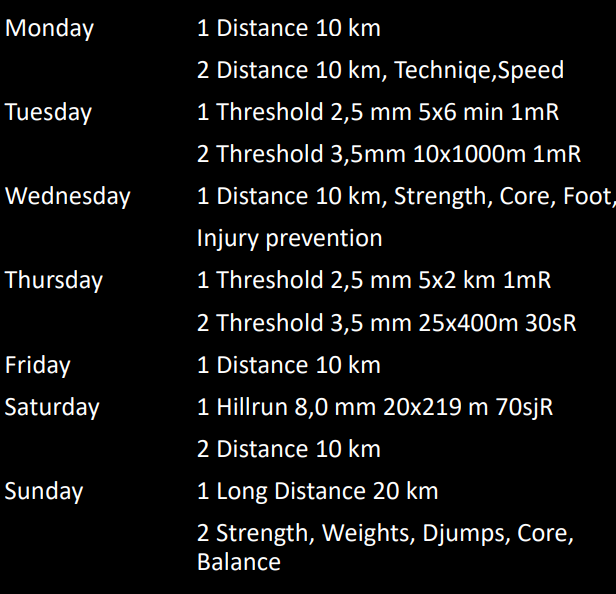
Return to Sport
It's been a second since I've wrote a blog post and I want to put down some of my thoughts since I've been transitioning back into running.
Total Training Volume
If we take a look at my volume in the last couple months when compared the the few months prior, there are a few things I noticed.

There is not a huge difference in overall training volume between the two periods because of swimming, cycling and conditioning that I was doing.
Taking a closer look, during the last few months my training volume has been much more consistently hovering around or above 8-10 hours of training, outside of tapering for important race weeks like Flying Pig 3/5/23 and West Point 4/2/23.
This consistency is thanks to me being more concrete about planning my training, as well as just being a result of feeling healthy enough to stick to my plans without bailing (as I often did when having issues with the knee).
There also has been a steady and healthy increase in the amount of running volume of the last couple months, including relatively consistent workouts, time trials and races which have helped contribute to my speed and motivation to keep up the training.
Running Volume
If we go week by week from February 12th which is when I really started to pick up the running again we can see the following trend in mileage.

Despite a few fluctuations due to races, the trend is upwards and the increase between weeks usually isn't too crazy (except from 13 to 14 which was experimental to say the least).
Planning out my training has helped decrease the amount of fluctuation and also allow for periodization (weeks with less running and some weeks with more running). And like I said earlier this has also helped with consistency.
If we look at the trendline, the cumulative increase has been at around 8% per week. A little high for my taste, but I think starting from around 20 miles, it's not too aggressive while also not being too conservative.
Threshold Workouts
Another key contributor to my triumphant return to running has been the use of high volume threshold training. I got interested in this after reading a lot about the Norwegian Training Model, particularly focusing on the type of training that the top performing Norwegian and Kenyan athletes do which involved a significant amount of volume being performed at relatively low intensity for interval work.

As shown in the above "training week" that Jakob Ingebristen does, a vast majority of the interval work is at 2.5mm to 3.5mm of lactate in the blood which for most people ends up being a relatively slow pace, usually around what you could maintain for a half marathon distance. Since I don't have a lactate meter I've been estimating my lactate threshold pace using primarily heart rate and rate of perceived exertion, but I've even been considering coughing up the money for a meter considering how effective this training has been for me already and how much more effective it could be if I could more accurately target my lactate threshold.
Anyways, since I've been slowly returning back to a higher amount of running I began introducing frequent threshold workouts as opposed to track workouts at a faster pace, and I've been extremely impressed with the return on investment. I crushed my mile PR and 2-mile PR by a long shot, essentially a 40+ second improvement in my 2-mile time within 3 months of consistent training which is quite significant.
Cross Training
Throughout the last couple months (and even throughout my injury) I've used cross training to maintain a high volume of aerobic intensity which also not building up the running volume too quickly which has helped me maintain a good level of fitness which has made it easier to balance the running training and also get much better returns on the threshold intensity work that I'm doing.
Quantity and quality are both important in terms of becoming a better endurance athlete, but it's easy to get caught up in pursuing one but not the other. Making my running sessions focused on quality threshold work and only some volume at a lower intensity has allowed me to really hone the quality of my running training while at the same time not increasing the volume too quickly.
Doing a lot of lower intensity work on the bike and elliptical takes a lot of the stress away from the impact forces which cause a majority of the injuries in the foot and lower leg. This has allowed me to maintain a high volume of aerobic intensity without having to worry about the impact forces that come with running, and thus I can take as much time as I need to build up the running volume and get the adaptations I need to maintain it.
Conclusions
I've been extremely happy with my return to running and I'm excited to see what I'm able to do in the next couple of months when it comes to certain key races and time trials leading up to the North American Orienteering Championships in Tahoe.
My focus is still on learning how to train better and smarter, I'm super excited that I've found a protocol that I really enjoy and that has worked well for me so far although I'm still wary of injury because I know from experience it is always lurking around the next corner.
Some upcoming smaller goals include running my first half marathon (this Sunday!). Trying to go under 16 minutes in the 5KM which I'll probably attempt right around my graduation in mid-June. Then, all the focus goes toward NAOC and orienteering training until those races, THEN I shift gears once again to Triathlon training to prepare for a half-Ironman distance in September which I'm really looking forward to. Glad to be back and I'll be sure to keep you all updated on whatever comes next!